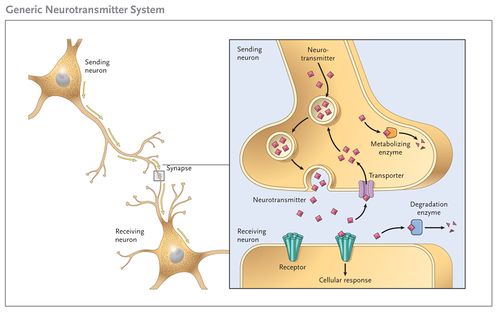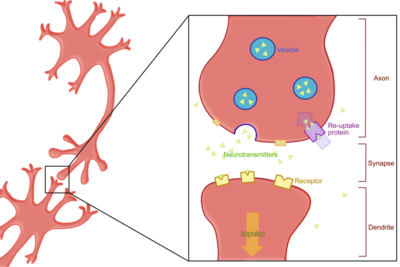Neurotransmitters
Original Editor - Lucinda hampton
Top Contributors - Lucinda hampton, Vidya Acharya and Kim Jackson
Introduction[edit | edit source]
Neurotransmitters are endogenous chemicals that allow neurons to communicate with each other throughout the body. They enable the brain to provide a variety of functions, through the process of chemical synaptic transmission.
- They send information between neurons by crossing a synapse. Electrical signals are not able to cross the gap between most neurons and are changed into chemical signals to cross the gap. Neurotransmitters act mostly on chemical synapses. Once they reach the next neuron they are absorbed. The neuron then changes this chemical signal back into an electrical signal called an action potential. The action potential passes across the next neuron and to the next synapse.
- Many neurotransmitters are made from amino acids, which are part of your diet and it takes only a few steps to convert them.
- Neurotransmitters play a major role in shaping everyday life and functions. We don't know exactly how many neurotransmitters exist, but more than 100 chemical messengers have been identified and each neurotransmitter has a different function[1].
- Until the early 20th century, scientists assumed that the majority of synaptic communication in the brain was electrical. However, through the careful histological examinations by Ramón y Cajal (1852–1934), a 20 to 40 nm gap between neurons, known today as the synaptic cleft, was discovered.
- Alterations in the levels of specific neurotransmitters have been observed in various neurological disorders, including Parkinson disease, schizophrenia, depression, and Alzheimer disease[2].
Function[edit | edit source]
Neurotransmitters transmit signals from nerve cells to target cells. These target cells may be in muscles, glands, or other nerves.
The brain needs neurotransmitters to regulate many necessary functions, including:
- heart rate
- breathing
- sleep cycles
- digestion
- mood
- concentration
- appetite
- muscle movement[3]
There are a number of neurotransmitters used by the body for different functions eg acetylcholine, glutamate, GABA, glycine, dopamine, norepinephrine, and serotonin.
- Glutamate is the principal excitatory neurotransmitter used in the brain. It is also the primary mediator of nervous system plasticity. Glutamate has been implicated in modifiable synapses, which researchers suspect are the memory-storage elements of the brain.
- Gamma-aminobutyric acid (GABA) and glycine, conversely, serve as the major inhibitory neurotransmitters. GABA, eg can account for approximately 40% of the inhibitory processing in the brain.
- Acetylcholine (ACh): One of the most important neurotransmitters found in multiple synapses in the body, including the neuromuscular junction, autonomic ganglia, caudate nucleus, and the limbic system. Generally, ACh is an excitatory neurotransmitter at the neuromuscular junction and in the autonomic ganglia.
- Glycine is found primarily in the spinal cord.
- Dopamine, another major neurotransmitter, plays an essential role in several brain functions, including learning, motor control, reward, emotion, and executive functions. Dopamine has also been implicated in psychiatric and neurological disorders.
- Serotonin is a neurotransmitter that modulates multiple neuropsychological processes and neural activity — many drugs used in psychiatry and neurology target serotonin. Serotonin also has implications that affect gastrointestinal processes like bowel motility, bladder control, and cardiovascular function.
- Norepinephrine. The most important molecule in sympathetic nervous system signaling, except for the sweat glands. The release of norepinephrine in the brain exerts effects on a variety of processes, including stress, sleep, attention, focus, and inflammation. It also plays a role in modulating the responses of the autonomic nervous system.
- Histamine is another neurotransmitter that mediates homeostatic functions in the body, promotes wakefulness, modulates feeding behavior, and controls motivational behavior[2]
Neurotransmitters and Health[edit | edit source]
Alterations in the levels of specific neurotransmitters have been observed in various neurological disorders. Below are some findings:
- Gamma-aminobutyric acid (GABA), the major inhibitory neurotransmitter in the central nervous system, is targeted in the treatment of anxiety disorder, insomnia, epilepsy, and other conditions. In particular, these drugs alter GABAergic function by targeting the GABA-A and GABA-B receptors.
- Dopamine plays an important role in multiple physiological processes and has a role in the pathology of psychiatric and neurodegenerative diseases. Disturbances in the neurotransmission of dopamine are implicated in schizophrenia, psychosis, depression, Tourette syndrome, and attention deficit hyperactivity disorder. Dopamine is related to Parkinson disease, multiple sclerosis, and Huntington's disease. Research suggests that the degeneration of dopaminergic neurons in the substantia nigra pars compacta is involved in the pathogenesis of Parkinson disease.
- Serotonin, a neurotransmitter that controls several neuropsychiatric processes, has been implicated in the pathogenesis of depression. Research has shown that patients with endogenous depression have low plasma levels of tryptophan, a precursor of serotonin. Postmortem studies found an association between decreased serotonin levels in the brain and suicide, among depressed patients. Drugs have been developed that target serotonin in the treatment of depression. eg. tricyclic antidepressants work by increasing serotonin levels in the synapse.
- Norepinephrine is involved in the pathogenesis of neuropsychiatric disorders. Conditions related to norepinephrine dysfunction include anxiety disorders, mood disorders, attention-deficit hyperactivity disorder, Alzheimer’s disease, and posttraumatic stress disorder. Many symptoms in these disorders are directly attributable to norepinephrine dysfunction in the neural circuitry.
- A prominent contributor to the pathogenesis of IgE-mediated diseases is the neurotransmitter histamine. Produced in mast cells, histamine exerts its effects in the body by binding to certain histamine receptors. Two of the cardinal features of asthma, bronchospasm, and mucosal edema, are directly related to histamine receptor stimulation Histamine is also implicated in the pathogenesis of multiple sclerosis, which is characterized by inflammatory demyelination in the central nervous system. In animal models, histamine has been shown to change the blood-brain barrier permeability. This change in permeability led to an increase of cells infiltrating the central nervous system, subsequently increasing neuroinflammation[2]
References[edit | edit source]
- ↑ Kidzsearch Neurotransmitters Available from:https://wiki.kidzsearch.com/wiki/Neurotransmitter (accessed 23.12.2020)
- ↑ 2.0 2.1 2.2 Sheffler ZM, Reddy V, Pillarisetty LS. Physiology, Neurotransmitters. InStatPearls [Internet] 2020 May 21. StatPearls Publishing Available from:.https://www.ncbi.nlm.nih.gov/books/NBK539894/ (accessed 23.12.2020)
- ↑ Very well health Neurotransmitters Available from: https://www.medicalnewstoday.com/articles/326649(accessed 23.12.2020)
- ↑ Whats Up DudeNeurotransmitters - What Are Neurotransmitters And What Do They Do In The Body?Available from:https://www.youtube.com/watch?v=Mz3PIvyu3ew








